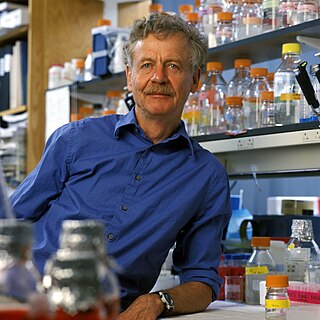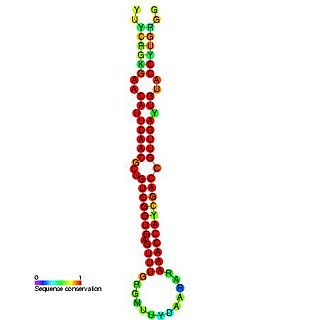Related Research Articles

An oncovirus or oncogenic virus is a virus that can cause cancer. This term originated from studies of acutely transforming retroviruses in the 1950–60s, when the term "oncornaviruses" was used to denote their RNA virus origin. With the letters "RNA" removed, it now refers to any virus with a DNA or RNA genome causing cancer and is synonymous with "tumor virus" or "cancer virus". The vast majority of human and animal viruses do not cause cancer, probably because of longstanding co-evolution between the virus and its host. Oncoviruses have been important not only in epidemiology, but also in investigations of cell cycle control mechanisms such as the retinoblastoma protein.
A genetic marker is a gene or DNA sequence with a known location on a chromosome that can be used to identify individuals or species. It can be described as a variation that can be observed. A genetic marker may be a short DNA sequence, such as a sequence surrounding a single base-pair change, or a long one, like minisatellites.

The Wellcome Sanger Institute, previously known as The Sanger Centre and Wellcome Trust Sanger Institute, is a non-profit British genomics and genetics research institute, primarily funded by the Wellcome Trust.

Devil facial tumour disease (DFTD) is an aggressive non-viral clonally transmissible cancer which affects Tasmanian devils, a marsupial native to the Australian island of Tasmania. The cancer manifests itself as lumps of soft and ulcerating tissue around the mouth, which may invade surrounding organs and metastasise to other parts of the body. Severe genetic abnormalities exist in cancer cells - for example, DFT2 cells are tetraploid, containing twice as much genetic material as normal cells. DFTD is most often spread by bites, when teeth come into contact with cancer cells; less important pathways of transmission are ingesting of infected carcasses and sharing of food. Adult Tasmanian devils who are otherwise the fittest are most susceptible to the disease.

A canine transmissible venereal tumor (CTVT), also known as a transmissible venereal tumor (TVT), canine transmissible venereal sarcoma (CTVS), sticker tumor and infectious sarcoma, is a histiocytic tumor of the external genitalia of the dog and other canines, and is transmitted from animal to animal during mating. It is one of only three known transmissible cancers in mammals; the others are devil facial tumor disease, a cancer which occurs in Tasmanian devils, and contagious reticulum cell sarcoma of the Syrian hamster.

Bert Vogelstein is director of the Ludwig Center, Clayton Professor of Oncology and Pathology and a Howard Hughes Medical Institute investigator at The Johns Hopkins Medical School and Sidney Kimmel Comprehensive Cancer Center. A pioneer in the field of cancer genomics, his studies on colorectal cancers revealed that they result from the sequential accumulation of mutations in oncogenes and tumor suppressor genes. These studies now form the paradigm for modern cancer research and provided the basis for the notion of the somatic evolution of cancer.

Rudolf Jaenisch is a Professor of Biology at MIT and a founding member of the Whitehead Institute for Biomedical Research. He is a pioneer of transgenic science, in which an animal’s genetic makeup is altered. Jaenisch has focused on creating genetically modified mice to study cancer, epigenetic reprogramming and neurological diseases.
A transmissible cancer is a cancer cell or cluster of cancer cells that can be transferred between individuals without the involvement of an infectious agent, such as an oncovirus. The evolution of transmissible cancer has occurred naturally in other animal species, but human cancer transmission is rare.

In molecular biology miR-181 microRNA precursor is a small non-coding RNA molecule. MicroRNAs (miRNAs) are transcribed as ~70 nucleotide precursors and subsequently processed by the RNase-III type enzyme Dicer to give a ~22 nucleotide mature product. In this case the mature sequence comes from the 5' arm of the precursor. They target and modulate protein expression by inhibiting translation and / or inducing degradation of target messenger RNAs. This new class of genes has recently been shown to play a central role in malignant transformation. miRNA are downregulated in many tumors and thus appear to function as tumor suppressor genes. The mature products miR-181a, miR-181b, miR-181c or miR-181d are thought to have regulatory roles at posttranscriptional level, through complementarity to target mRNAs. miR-181 which has been predicted or experimentally confirmed in a wide number of vertebrate species as rat, zebrafish, and in the pufferfish.

There are 89 known sequences today in the microRNA 19 (miR-19) family but it will change quickly. They are found in a large number of vertebrate species. The miR-19 microRNA precursor is a small non-coding RNA molecule that regulates gene expression. Within the human and mouse genome there are three copies of this microRNA that are processed from multiple predicted precursor hairpins:

Cancer is the leading cause of death in dogs. It is estimated that 1 in 3 domestic dogs will develop cancer, which is the same incidence of cancer among humans. Dogs can develop a variety of cancers and most are very similar to those found in humans. Dogs can develop carcinomas of epithelial cells and organs, sarcomas of connective tissues and bones, and lymphomas or leukemias of the circulatory system. Selective breeding of dogs has led certain pure-bred breeds to be at high-risk for specific kinds of cancer.

Sir Stephen Philip Jackson, FRS, FMedSci is the Frederick James Quick Professor of Biology. He is a senior group leader at the Cancer Research UK Cambridge Institute and associate group leader at the Gurdon Institute, University of Cambridge.

Katherine Belov is an Australian geneticist, professor of comparative genomics in the School of Life and Environmental Sciences and Pro Vice Chancellor of Global Engagement at the University of Sydney. She is head of the Australasian Wildlife Genomics Group and research expert in the area of comparative genomics and immunogenetics, including Tasmanian devils and koalas, two iconic Australian species that are threatened by disease processes. Throughout her career, she has disproved the idea that marsupial immune system is primitive, characterized the South American gray short-tailed opossum's immune genes, participated in the Platypus Genome Project, led research identifying the properties of platypus venom, and identified the cause of the spread of the Tasmanian devil's contagious cancer.
Duncan Odom is a research group leader at the German Cancer Research Center (DKFZ) in Heidelberg, and the Cancer Research UK Cambridge Institute at the University of Cambridge. Previously he was as an associate faculty member at the Wellcome Trust Sanger Institute from 2011 to 2018.
Anne-Maree Pearse is an Australian cytogeneticist who is credited with the theory that some cancer cells can be transmissible between individuals. This is known as the Allograft Theory. Her work has focussed on devil facial tumour disease (DFTD), a contagious cancer that affects Tasmanian devils. For this she has won multiple awards, including the 2012 Prince Hitachi Prize for Comparative Oncology.
Horizontal transfer of mitochondria is the movement of whole mitochondria and mitochondrial DNA between cells. Mitochondria from donor cells are transported and incorporated into the endogenous mitochondrial network of recipient cells contributing to changes in the bioenergetics profile and in other functional properties of recipient cells. Horizontal cell-to-cell transfer of mitochondria and mitochondrial genome can occur among mammalian cells in vitro and in vivo. Mitochondrial transfer supports the exogenous replacement of damaged mitochondria, thereby rescuing mitochondrial defects. Stem cells, immortalized cells or primary cells are usually used as mitochondrial donors in most studies. These cells may transfer mitochondria to surrounding cells in their niche, thus affecting cell differentiation, proliferation, tissue homeostasis, development and ageing.
Serena Nik-Zainal is a British-Malaysian clinician who is a consultant in clinical genetics and Cancer Research UK advanced clinician scientist at the University of Cambridge. She makes use of genomics for clinical applications. She was awarded the Crick Lecture by the Royal Society in 2021.
Contagious reticulum cell sarcoma is a reticulum-cell sarcoma found in Syrian hamsters that can be transmitted from one hamster to another. It was first described in 1945.
Lynn Corcoran is an American–Australian immunologist who is Professor of Immunology at the Walter and Eliza Hall Institute. Her research considers cancer, parasitology and immunology, with a focus on B cells biology. She was inducted into the Victorian government's Honour Roll in 2013.
References
- ↑ "Transmissible Cancer Group". www.tcg.vet.cam.ac.uk.
- ↑ "Save the Tasmanian Devil website". savethetasmaniandevil.org.au. Archived from the original on 12 June 2016. Retrieved 7 July 2015.
- ↑ Murchison EP et al. Genome sequencing and analysis of the Tasmanian devil and its transmissible cancer. Cell. Feb 17;1484:780-91 (2012)
- ↑ Murchison EP et al. The Tasmanian devil transcriptome reveals Schwann cell origins of a clonally transmissible cancer. Science. Jan 1 3275961:84-7 (2010)
- ↑ Zimmer, Carl (26 March 2018). "Saving Tasmanian Devils From Extinction". The New York Times– via NYTimes.com.
- ↑ Murchison EP et al. Transmissible dog cancer genome reveals the origin and history of an ancient cell lineage. Science. Jan 24;3436169:437-40 (2014)
- ↑ "Übertragbarer Tumor: Hunde-Krebs entstand vor 11.000 Jahren". Der Spiegel. 24 January 2014 – via Spiegel Online.
- ↑ Borrell, Brendan (2014). "How a contagious dog tumour went global". Nature. doi:10.1038/nature.2014.14580. S2CID 184202908.
- ↑ bb258@cam.ac.uk (2 March 2015). "Elizabeth Murchison — Transmissible Cancer Group". www.tcg.vet.cam.ac.uk. Retrieved 26 March 2018.
- ↑ Murchison, Elizabeth (22 September 2011), Fighting a contagious cancer , retrieved 26 March 2018